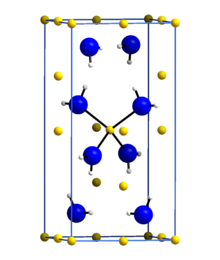Lithium amide
 | |
| Names | |
|---|---|
| IUPAC name
Lithium amide
| |
| Other names
Lithium azanide
Lithamide | |
| Identifiers | |
3D model (
JSmol ) |
|
| ChemSpider | |
ECHA InfoCard
|
100.029.062 |
PubChem CID
|
|
| UNII | |
CompTox Dashboard (EPA)
|
|
| |
| |
| Properties | |
| LiNH2 | |
| Molar mass | 22.96 g·mol−1 |
| Appearance | white solid |
| Density | 1.178 g/cm3 |
| Melting point | 375 °C (707 °F; 648 K) |
| Boiling point | 430 °C (806 °F; 703 K) decomposes |
| reacts | |
| Solubility | slightly soluble in ethanol insoluble in ammonia |
| Thermochemistry | |
Std enthalpy of (ΔfH⦵298)formation |
-182 kJ/mol |
| Hazards | |
| NFPA 704 (fire diamond) | |
Except where otherwise noted, data are given for materials in their standard state (at 25 °C [77 °F], 100 kPa).
| |
Lithium amide or lithium azanide is an inorganic compound with the chemical formula LiNH2. It is a white solid with a tetragonal crystal structure.[1] Lithium amide can be made by treating lithium metal with liquid ammonia:[2]
- 2 Li + 2 NH3 → 2 LiNH2 + H2
Other lithium amides
The conjugate bases of amines are known as amides. Thus, a lithium amide may also refer to any compound in the class of the lithium salt of an
lithium hexamethyldisilazide
(LiHMDS). They are produced by the reaction of Li metal with the appropriate amine:
- 2 Li + 2 R2NH → 2 LiNR2 + H2
Lithium amides are very reactive compounds. Specifically, they are strong bases.
Examples
Lithium tetramethylpiperidide has been crystallised as a tetramer.[3] On the other hand, the lithium derivative of bis(1-phenylethyl)amine crystallises as a trimer:[4]
 |
 |
It is also possible to make mixed oligomers of metal
superbases, which are mixtures of metal alkoxides and alkyls. The cyclic oligomers form when the nitrogen of the amide forms a sigma bond to a lithium, while the nitrogen lone pair
binds to another metal centre.
Other organolithium compounds (such as
BuLi
) are generally considered to exist in and function via high-order, aggregated species.
See also
References
- PMID 17243680.
- ^ P. W. Schenk (1963). "Lithium amide". In G. Brauer (ed.). Handbook of Preparative Inorganic Chemistry, 2nd Ed. Vol. 1. NY, NY: Academic Press. p. 454.
- .
- doi:10.1039/A904725E.
- .
- Merck Index, 11th Edition, 5398.

